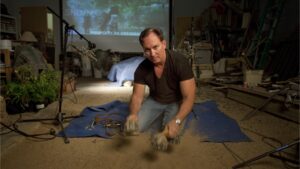Behind the Magic: The Art of Foley Sound in Hollywood
Welcome to the Extreme Investor Network blog, where we not only explore lucrative business opportunities but also delve into the creative industries that define our modern storytelling landscape. One of the most fascinating and often overlooked aspects of filmmaking is the art of Foley sound. Today, we take a behind-the-scenes look at the magical world of Foley artistry, highlighting the expertise of industry veteran Gary Hecker, who has been bringing Hollywood’s biggest blockbusters to life through sound.
The Maestro of Sound Effects
Nestled within the bustling Sony Pictures lot, Gary Hecker is a true craftsman in his domain. With over 400 film titles under his belt—including iconic films like "Star Wars: The Empire Strikes Back" and Tarantino’s "Once Upon a Time in Hollywood"—Hecker specializes in creating the subtle sound effects that enhance our cinematic experience. Whether it’s the clang of a sword, the patter of footsteps, or even the swoosh of a superhero’s cape, every sound effect Hecker crafts adds layers of depth and emotion to a scene.
Rodger Pardee, a professor at Loyola Marymount University, emphasizes the significance of Foley in filmmaking. He states, "Foley is… for the footsteps of someone running through a forest or rock climbing, or the swish of a superhero’s cape. Foley gives you the details. It anchors the sound mix." As Hollywood begins to adopt artificial intelligence in various capacities, the unique, human touch of Foley artistry continues to be a vital component of film production.
A Craft Rooted in History
The origin of Foley sound can be traced back to the late 1920s during Hollywood’s transition from silent films to "talkies." Jack Foley, the namesake of this sound technique, discovered that live, synchronized sound effects provided a more immersive experience for audiences. Nearly a century later, Hecker and his peers continue to use similar techniques, proving that the human touch remains irreplaceable in studio sound production.
Hecker’s Foley studio is a treasure trove of sound-making materials. From a variety of shoes that mimic different types of footsteps to an arsenal of kitchen utensils that can transform into an orchestra of sounds, Hecker has spent over 45 years curating a collection that ranges from simple props to elaborate mechanical devices. Every item, every sound, has its purpose in bringing the film to life.
The Quest for Authenticity
Hecker’s passion for authenticity is evident in his work. "We do the film from top to bottom," he explains, meticulously shaping sounds to match the on-screen action. For bigger films, he may spend anywhere from 18 to 20 days perfecting the sounds along with his partner, mixer Jeff Gross. Together, they adopt a hands-on approach, layering sounds, and often employing unique methods to capture the essence of every scene.
For example, Hecker ingeniously creates the sound of a metallic scrape by rubbing a battleship howitzer shell against a concrete surface. Similarly, to achieve realistic footsteps, he might incorporate coffee grounds for added grit. This commitment to realism showcases the artistry and dedication that Foley artists like Hecker bring to the film industry—a stark contrast to the quick fixes that artificial intelligence might offer.
The Future of Foley in an AI World
As Hollywood grapples with the impact of AI on various facets of production, Hecker expresses confidence in the irreplaceable quality of human artistry. "Actors’ performances—between motion and detail—AI can’t do that," he affirms. While software programs that simulate Foley sounds have been developed, the consensus is that they fall short of capturing the nuanced variations inherent in human performance.
Interestingly, Hecker remains relatively unconcerned about AI’s potential to take over the Foley industry. Instead, he acknowledges the threats posed by the reduced output of films from major studios, which have collectively opted for fewer releases amid budget constraints. This trend symbolizes a potential challenge for Foley artists, particularly as streaming platforms generally maintain lower sound budgets compared to traditional films.
Keeping the Human Element in Sound
Hecker sums up his dedication to Foley with a simple mantra: "I would do anything to get a sound." His physical commitment to achieving perfect sound effects highlights the human element that distinguishes Foley artistry from computer-generated alternatives. As the industry continues to evolve, it is crucial to preserve this human touch, which adds depth, engagement, and authenticity to the cinematic experience.
Ultimately, the craft of Foley sound exemplifies the fine line between art and technology, reminding us that creativity still holds a unique place amidst the rise of machines. At Extreme Investor Network, we recognize the importance of such artistry in the business of entertainment and are eager to share stories that shine a light on the people and techniques that make filmmaking truly magical.
For further insights into unique career opportunities in the creative industries, stay tuned to our blog. As we explore trends, investment opportunities, and remarkable individuals reshaping our world, we invite you to join us on this journey!

